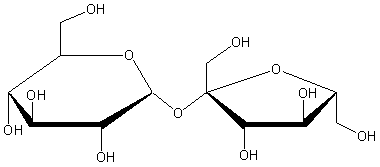Sucrose
|
|
Sucrose is the common chemical name for table sugar. Sucrose is a disaccharide; each molecule of sucrose consists of two "simple sugars" (monosaccharides).
| Contents |
Composition
In sucrose, a glucose residue and a fructose residue are linked by an 1→2-α,β-glycosidic bond. Sucrose's empirical formula is C12H22O11, and its systematic name is α-D-glucopyranosyl-(1→2)-β-D-fructofuranoside.
( α(1-2) pronounced alpha-one-two )
Production
Sucrose is a covalently bonded compound. Sucrose is generally extracted from sugar cane or sugar beet and then purified and crystallized. Other (minor) commercial sources are sorghum and sugar maples.
Crystalline nature
When you add sugar to water, the sugar crystals dissolve and the sugar goes into solution. But you can't dissolve an infinite amount of sugar into a fixed volume of water. When as much sugar has been dissolved into a solution as possible, the solution is said to be saturated.
The saturation point is different at different temperatures. The higher the temperature, the more sugar that can be held in solution.
When you cook up a batch of candy, you cook sugar, water, and various other ingredients to extremely high temperatures. At these high temperatures, the sugar remains in solution, even though much of the water has boiled away. But when the candy is through cooking and begins to cool, there is more sugar in solution than is normally possible. The solution is said to be supersaturated with sugar.
Supersaturation is an unstable state. The sugar molecules will begin to crystallize back into a solid at the least provocation. Stirring or jostling of any kind can cause the sugar to begin crystallizing.
Sucrose melts and decomposes at 186 °C to form caramel, and when burnt produces carbon dioxide and water.
Usage
Sucrose is the most common sweetener in the modern, industrialized world, although it has been displaced in industrial food production by some other sweeteners such as glucose syrups or combinations of functional ingredients and high intensity sweeteners.
Its ubiquitosity is due to the combination of sweetness and functional properties; it is impotant to the structure of many foods including biscuits (cookies), ice cream and sorbets, and also gives preserving qualities to foods. as such it is common in many processed and "junk" foods.
People, and in fact most other mammals except members of the cat family, will gladly accept a food sweetened with sucrose, even if they aren't hungry.
In the human digestive system
Sucrose is broken down in the gut by acidic hydrolysis into its component sugars fructose and glucose which are then absorbed into the bloodstream through the intestine.
Health effects
Sucrose has been linked with some adverse health effects. The most common is tooth decay, in which bacteria in the mouth convert sucrose in food to produce acids that attack tooth enamel. Sucrose has a high food energy content and in a poorly managed diet can contribute to obesity. People with diabetes mellitus need to control their intake of sucrose along with the other carbohydrates.
Properties
- Solubility in water: about 2.1 g sucrose in 1 g water (at 25 °C).
- Refractive index of 10% solution:
- Melting point: 186 °C
- Energy density: 17 kJ.g-1
- Molecular Weight: 342.3 g.mol-1
source (http://www.science.edu.sg/ssc/detailed.jsp?artid=2382&type=6&root=5&parent=5&cat=53)bg:Захароза da:Sucrose de:Saccharose es:Sacarosa eo:Sakarozo fr:Saccharose ko:자당 is:Sykrur it:Saccarosio he:סוכרוז zh-min-nan:Chià-thn̂g nl:Sucrose ja:スクロース nn:Sukrose pl:Sacharoza zh:蔗糖

